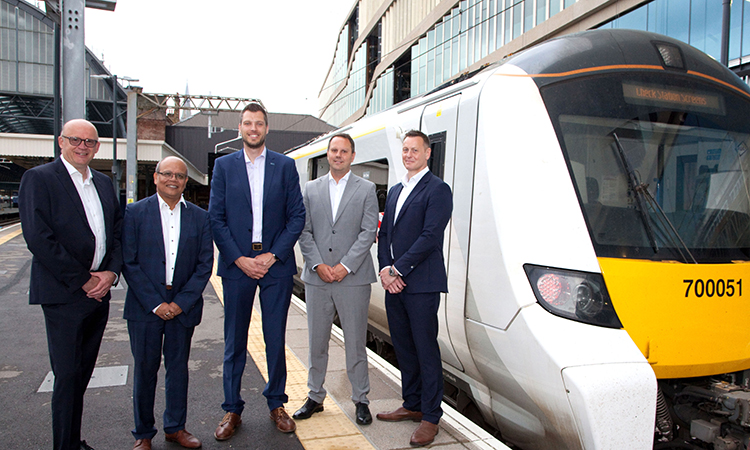The importance of the Thameslink Class 700 digital upgrade
Posted: 8 August 2023 | Ben Lane, Ed Akers, Oly Turner | No comments yet
Global Railway Review spoke with Ed Akers, Network Rail’s Principal Programme Sponsor for ECDP, Oly Turner, GTR’s Head of ERTMS and Ben Lane, Siemens Mobility’s Project Director, ECDP, to discuss the significance of the Thameslink Class 700 fleet upgrade, and how it fits within a wider digital transformation.


Credit: Network Rail
Could you start by talking about the importance of ETCS?
Ed: “The basic principles of railway signalling have remained unchanged since the mid 19th century. There’s always been a need to safely regulate the speed of moving trains, and for generations we’ve been installing fixed signals to do just that that. This means a reliance on train drivers looking out of their cab window to receive basic instructions to slow down, stop or accelerate. Continuous speed-based signalling, using ETCS, provides real time information directly to the driver through a screen in the cab. Without the reliance on looking out of the cab window for fixed signals, ETCS enables more efficient use of capacity and more capability and is even safer due to the automatic train protection (ATP) it provides.”
Oly: “Digital signalling gives the train driver planning information and speed protection stretching miles ahead – effectively, drivers can ‘see’ around corners, drive more consistently, and it gives them even greater safety controls. It also allows train and track to ‘talk’ to each other continuously – rather than at fixed points as today. This will mean that signallers can continuously communicate with every train on the network and respond to information in real time.”
Ben: “The end goal of the East Coast Digital Programme (ECDP) is to completely change the experience of passengers and freight operators on the line through delivering an industry-leading train control and traffic management solution. Each train will be constantly monitored to ensure that it is not moving faster or further than is safe, with the protection of on-board systems intervening if absolutely necessary.
“Through new technologies and digitalisation, we are able to unlock benefits earlier by reducing trackside assets and being able to diagnose any issues encountered remotely – making it quicker to assess the right solutions, whilst limiting the time trackside workers spend out on site.”
Oly: “Ultimately, better information for both the driver and signaller, and being able to respond in real time, will smooth the flow of trains, meaning a more reliable service for our customers. It will get people on the move again more quickly if there are delays. In the first phase of the programme, we’re introducing digital signalling on the Northern City Line in central London.”
Ed: “Renewing conventional signalling is getting more expensive and complex; you’re having to deal with things like floating signals on huge gantries across multiple tracks that require power supply and monitoring equipment, ensuring proper sighting distance whilst avoiding bridges, OLE masts and so on. ETCS provides an opportunity to achieve more for less. Broadly speaking, digital signalling involves almost half the unit cost, half the access, and half the embedded carbon. The ECDP is providing the foundation for what will become a long-term rolling programme of ETCS based renewals across the network.”
Can you give us a general overview of the contract to upgrade the Class 700 Thameslink fleet with the latest specifications of ETCS?
Ben: “The Class 700 has been operating with ETCS in central London since its introduction in 2016 providing continuous, real-time information to the driver’s cab. This hardware and software upgrade will help improve reliability and continue to transform rail travel and transport in London, the South East and East of England. The 115-strong fleet will be upgraded over three years. Software design and development for the upgrade will take place from this summer, with a programme of testing and commissioning on the first-in-class 700 unit set to get under way from 2024. The entire fleet will be upgraded in 2026 following the completion of the safety approvals and validation process.”
Oly: “The five-year contract encompasses hardware and software upgrades which will allow the trains to make use of the very latest digital infrastructure due to be installed on the East Coast Mainline. It includes elements like ‘packet switching’ GSMR radios, which significantly increase data capacity on a busy mixed-use railway, and online ‘key management’ which provides advanced data security. More generally it provides better diagnostics and fault finding.
“ETCS is constantly evolving to react to the latest demands of railways worldwide and this development cycle ensures we are providing our customers with the safest railway that is able to deliver benefits in line with our future customers’ demands.”
Ed: “Preparing and upgrading trains is the biggest challenge the ECDP faces. You might naturally think the challenge is about the technology, but in reality it’s more about the complexity involved with many partners and complex commercial arrangements, such as the private finance initiative provisions associated with GTR’s Class 700 fleet. We have had to prioritise ensuring this particular contract is in place because it involves the largest passenger fleet in the programme and is pivotal to its success. The capability of the upgraded ETCS units will help ensure that ECDP delivers an overall step-change to the reliability and resilience of train services on the East Coast Main Line.”
How does this contract relate to the East Coast Digital Programme and wider deployment of digital signalling?
Ed: “Upgrading the largest ECDP passenger fleet to the latest standard of ETCS is a big step forward for the ECDP as we prepare for the first deployment of digital signalling on the East Coast Main Line. There’s a lot of work taking place just now to deliver the lineside infrastructure between Welwyn Garden City and Hitchin in Hertfordshire that will enable us to begin operating trains with digital signalling over that section of route from 2025. Later this year, Great Northern expects to operate the first passenger trains in ETCS on the Northern City Line. These services are operated using Class 717 units, also due for a software upgrade as part of this contract.”
Oly: “The Class 700s cover some the busiest routes in the UK – in addition to the East Coast Mainline, they also serve routes on different main lines, across a vast area in the south of England.”
Ed: “By upgrading the fleet to the very latest standard of ETCS it gives potential for the industry to continue ETCS deployment into other parts of the network.”
Oly: “For our Class 700 Thameslink drivers, the changes from the current standard of ETCS to the new standard through this upgrade will be minimal. In reality, the drivers won’t see much change; most of the changes relate to the functionality of the system within the train, such as the way it communicates with the lineside equipment – which, using this latest software iteration 3.6.0, will allow more trains to operate. The changes for the end-user are deliberately minimal to lessen the gap between the training they’ve already received, which should mean it’s a straightforward transition to the latest version of ETCS.”
Ben: “Upgrading the largest passenger fleet on the ECDP will ensure the trains are compatible with the upgraded infrastructure to further unlock the potential of the programme and the trains. The fleet not only travels on the East Coast route, but also the Midland Main Line and Brighton Main Line so earlier benefits and improved passenger experience will be spread much further, to those regions and localities. In doing so it helps lay the foundations for future ETCS expansion. Through the upgrade, more train drivers will be upskilled to the latest technology, creating opportunities to share learning and best practices with future fleets due to be upgraded.”
Could you talk about the cooperation between the companies for this contract and how the East Coast Digital Programme facilitated this?
Ed: “I’ve led and worked on many rail programmes and projects, and the ECDP is completely different. Its partnership model has removed a lot of traditional barriers across track and train, and it’s transforming how the industry works together. Often, many industry programmes have been heavily specified by Network Rail; with our model we work closely with operators and suppliers to create a ‘user centric’ design, which means engineers working closely with ‘end-users’ to configure the whole system to the needs of those who own, maintain and operate it. That allows us to keep the benefits to passengers and freight users at the forefront of our thinking. This model has been used to deliver the ‘pathfinder’ project on the Northern City Line, where the partners agreed upon an overlay solution to enable a smooth and gradual transition to ETCS following a complete set of renewals of ageing signalling equipment. The experience gained through that project will be pivotal to the programme of taking the Class 700s out for fitment, bringing them back in and preparing for the further roll out of ETCS operation.”
Oly: “GTR has vast experience with new train procurement. When it started the franchise in 2014 it took on the biggest fleet renewal strategy for any passenger operator at the time. This experience from GTR’s inception has allowed us to gain a deep understanding of our fleet contracts. Subsequent upgrades to these fleets in the prevailing years have taught us valuable lessons in how to approach – and work with – our key stakeholders and suppliers. This experience, coupled with our relationship with Siemens Mobility UK and ECDP, meant we were able to create a solid specification on which to bid against and ultimately upgrade the trains to this latest specification.
“We also have extensive experience of navigating the safety approvals process that this type of upgrade necessitates – having recently achieved our received authorisation from the Office of Rail and Road (ORR) to place our Class 717 fleet into passenger service using Level 2 European Train Control System (ETCS) digital signalling on the Northern City Line later this year.”
Ben: “The most fundamental impact of the ECDP so far for the wider rail industry is proving that the partnership model is the right approach for such a transformative programme. On a programme as complex as this one it is essential to have a “one team” culture, with the whole programme pulling together as one. Any issues are quickly discussed and resolved, and the right technology, and approaches are selected as a result. We truly are all pulling in the same direction, bringing new technology through a radical delivery model to deliver a railway fit for the future.
”The first phase, introducing ETCS to the Northern City Line, has played a major role in the early successes that have shown the model can work. To date, ETCS equipment has been installed on the line by the delivery partners and test trains have been operated. This has involved on-board fitment for a range of Siemens Mobility Class 700 and 717 trains. Through the Northern City Line project, we are able to refine approaches, procedures and sign-offs, setting the standards for future roll-out on later sections. This will make future tranches quicker, less disruptive and more efficient in delivery.”


Ed Akers is Principal Sponsor for the East Coast Digital Programme. He has led various major infrastructure investments including the £1.5 billion East Coast Upgrade involving the re-modelling of the Kings Cross area and the Werrington Grade Separation, and the £2 billion Midland Mainline Programme involving the re-modelling of the Derby area and the London to Corby electrification and capacity improvement.


Oly Turner is Head of ERTMS (European Rail Traffic Management System) and leads the East Coast Digital Programme at Govia Thameslink Railway. He’s responsible for overseeing the introduction of digital in-cab signalling and related projects across three train fleets on the Northern City Line and East Coast Mainline. He has 17 years’ experience on the railway, including driving trains, working in operational safety, and construction.
Ben Lane is responsible for delivering the infrastructure projects for the East Coast Digital Programme, removing life expired existing assets and replacing them with the first major deployment of digital signalling with traffic management on an intercity main line railway in the UK. He is a highly motivated Project Director and former Regional Commercial Manager with almost 20 years of experience across the rail and highways sectors.
Related organisations
Govia Thameslink Railway (GTR), Network Rail, Siemens Mobility








